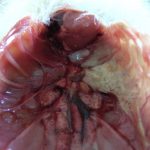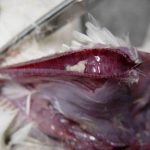Aviadenoviruses (formerly) adenovirus type 1 are a group of various hepatic and/or pancreatic tropism infections in many bird species. In general, aviadenoviruses are low pathogenic and appear to require a prior immunosuppressive factor to cause disease. The economic impact is difficult to assess given the high ubiquity of the virus and the variability in pathogenicity of the strains.
The disease agent and its pathogenicity
The etiological agent is the aviadenovirus. The aviadenoviruses are divided into 5 species (A to E according to molecular criteria). Adenovirus is an unenveloped, icosahedral symmetric, DNA virus, 70-90 nm in diameter. Replication takes place in the nucleus, which leads to intranuclear inclusions. The virus is resistant to lipid solvents, and at pH from 3 to 9.
There are several serotypes that vary greatly in pathogenicity and show partial cross-reactions between them. The infection is often asymptomatic. Several serotypes are often isolated in the same bird. The virus is ubiquitous in birds.
Avian viruses cause various diseases: infectious hepatitis, hydropericardium syndrome/hepatitis, various liver and/or pancreatic infections, respiratory pathologies.
Immunosuppression plays a role in the development of the disease, infectious hepatitis is often associated with anemia and lymphoid depletion. But some serotypes can induce the disease primarily, others could cause immunosuppression.
Immunity is specific to each serotype (despite partial cross-reactivity). It is effective but short-lived, so birds can be re-infected.
Epidemiological data
- There are many hosts. Infectious hepatitis mainly affects chickens, but it is also reported in other species.
- Hydropericardium syndrome affects many species.
- Infections with hepatic and/or pancreatic tropism occur in ducks, geese, pigeons, guinea fowl (guinea fowl pancreatitis) and ostriches.
- Type 1 adenoviruses cause respiratory disease in hens, diphtheric and stenosic tracheitis in palmipeds, and infectious bronchitis for the quail
- In chicken, cases can be found on birds from 2 to 5 weeks old. Traditionally, they have a viral shedding peak at 4-6 weeks, and then during egg laying.
- Pigeon adenovirus typically affects birds less than a year old. The necrotizing hepatitis form is found in pigeons of all ages.
- Generally, most birds have antibodies against the virus in adulthood.
- Vertical transmission is very important. Horizontal transmission also exists, through droppings, respiratory system and also semen. It can be indirect via contaminated equipment, staff, transport.
Hydropericardium syndrome often follows a contamination by a vaccine.
Clinical manifestations of the disease
Symptoms
- Clinical signs appear suddenly.
- Infectious hepatitis: mortality is sudden and peaks after 3-4 days, then stops on the 5th day. Birds are apathetic, sometimes icteric. They die or recover in 2 days.
- Hydropericardium syndrome: mortality begins at 3 weeks, peaks at 4-8 days and then gradually decreases; it is average, from 10 to 30%. The signs are the same as those of infectious hepatitis. In an affected group, morbidity is low but mortality can be high.
- Pigeon adenoviruses: The classic form shows stunted birds with watery diarrhea, vomitings; the infection spreads in 2 days; without superinfection, the birds can recover but performance will be reduced. Mortality is often close to 100%. The necrotizing hepatitis form shows the same signs as in chicken.
- Quail bronchitis: The disease begins with a decrease in consumption and indolence. Breathing distress appears suddenly, sometimes with nervous disorders and conjunctivitis. Mortality can reach 100%.
- More generally, there is also a decrease in spawning and ADG described in the literature.
Lesions
- In chicken, there is often hepatomegaly, pale liver with numerous petechiae and/or whitish miliary foci, muscle hemorrhages, bursa of Fabricius atrophy and bone marrow aplasia. Tracheitis can also be found. At the histology, intranuclear inclusion bodies are observed in hepatocytes.
- Hydropericardium syndrome produces serous pericarditis, lungs and kidneys edema, with small necrotic foci in the myocardium and liver. There may also be gizzard erosion in broiler chickens.
- In pigeons, there is necrotizing hepatitis with similar lesions to those of chicken but more extensive necrosis and also affecting the pancreas.
- Quail bronchitis: The respiratory system contains abundant yellowish mucus. Tenosynovitis can also be found.
The diagnosis
Characteristic inclusion body
Virology: culture from faecal, pharyngeal or kidney isolates. PCR is available for some aviadenoviruses.
Serology of little interest because most birds have antibodies
Disease prevention and control
Above all, we must prevent infections that will cause immunosuppression.
There is currently no vaccine in France.
Disinfection is not very effective and vertical transmission is difficult to avoid. It is necessary to check if there has been a vertical transmission in order not to spread the disease. However, for particular buildings (impermeable floors and waterproof walls), it is possible to eliminate the virus.







